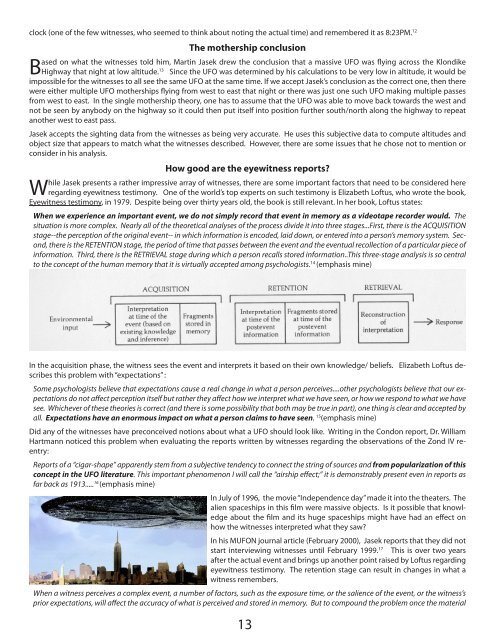You also want an ePaper? Increase the reach of your titles
YUMPU automatically turns print PDFs into web optimized ePapers that Google loves.
clock (one of the few witnesses, who seemed to think about noting the actual time) and remembered it as 8:23PM. 12<br />
The mothership conclusion<br />
Based on what the witnesses told him, Martin Jasek drew the conclusion that a massive UFO was flying across the Klondike<br />
Highway that night at low altitude. 13 Since the UFO was determined by his calculations to be very low in altitude, it would be<br />
impossible for the witnesses to all see the same UFO at the same time. If we accept Jasek’s conclusion as the correct one, then there<br />
were either multiple UFO motherships flying from west to east that night or there was just one such UFO making multiple passes<br />
from west to east. In the single mothership theory, one has to assume that the UFO was able to move back towards the west and<br />
not be seen by anybody on the highway so it could then put itself into position further south/north along the highway to repeat<br />
another west to east pass.<br />
Jasek accepts the sighting data from the witnesses as being very accurate. He uses this subjective data to compute altitudes and<br />
object size that appears to match what the witnesses described. However, there are some issues that he chose not to mention or<br />
consider in his analysis.<br />
How good are the eyewitness reports<br />
While Jasek presents a rather impressive array of witnesses, there are some important factors that need to be considered here<br />
regarding eyewitness testimony. One of the world’s top experts on such testimony is Elizabeth Loftus, who wrote the book,<br />
Eyewitness testimony, in 1979. Despite being over thirty years old, the book is still relevant. In her book, Loftus states:<br />
When we experience an important event, we do not simply record that event in memory as a videotape recorder would. The<br />
situation is more complex. Nearly all of the theoretical analyses of the process divide it into three stages...First, there is the ACQUISITION<br />
stage--the perception of the original event-- in which information is encoded, laid down, or entered into a person’s memory system. Second,<br />
there is the RETENTION stage, the period of time that passes between the event and the eventual recollection of a particular piece of<br />
information. Third, there is the RETRIEVAL stage during which a person recalls stored information..This three-stage analysis is so central<br />
to the concept of the human memory that it is virtually accepted among psychologists. 14 (emphasis mine)<br />
In the acquisition phase, the witness sees the event and interprets it based on their own knowledge/ beliefs. Elizabeth Loftus describes<br />
this problem with “expectations” :<br />
Some psychologists believe that expectations cause a real change in what a person perceives....other psychologists believe that our expectations<br />
do not affect perception itself but rather they affect how we interpret what we have seen, or how we respond to what we have<br />
see. Whichever of these theories is correct (and there is some possibility that both may be true in part), one thing is clear and accepted by<br />
all. Expectations have an enormous impact on what a person claims to have seen. 15 (emphasis mine)<br />
Did any of the witnesses have preconceived notions about what a UFO should look like. Writing in the Condon report, Dr. William<br />
Hartmann noticed this problem when evaluating the reports written by witnesses regarding the observations of the Zond IV reentry:<br />
Reports of a “cigar-shape” apparently stem from a subjective tendency to connect the string of sources and from popularization of this<br />
concept in the UFO literature. This important phenomenon I will call the “airship effect;” it is demonstrably present even in reports as<br />
far back as 1913..... 16 (emphasis mine)<br />
In July of 1996, the movie “Independence day” made it into the theaters. The<br />
alien spaceships in this film were massive objects. Is it possible that knowledge<br />
about the film and its huge spaceships might have had an effect on<br />
how the witnesses interpreted what they saw<br />
In his MUFON journal article (February 2000), Jasek reports that they did not<br />
start interviewing witnesses until February 1999. 17 This is over two years<br />
after the actual event and brings up another point raised by Loftus regarding<br />
eyewitness testimony. The retention stage can result in changes in what a<br />
witness remembers.<br />
When a witness perceives a complex event, a number of factors, such as the exposure time, or the salience of the event, or the witness’s<br />
prior expectations, will affect the accuracy of what is perceived and stored in memory. But to compound the problem once the material<br />
13


